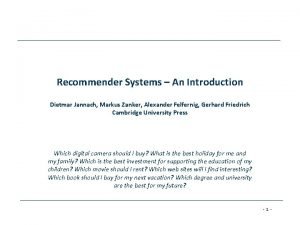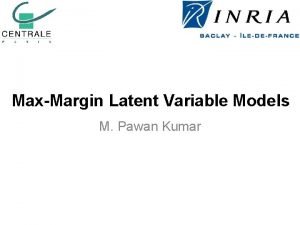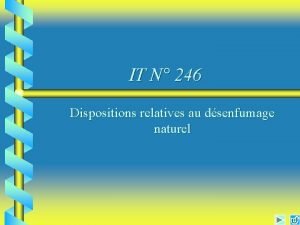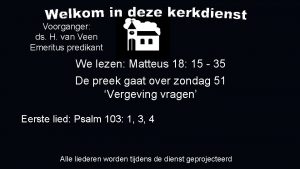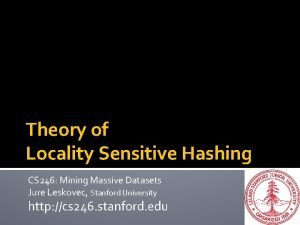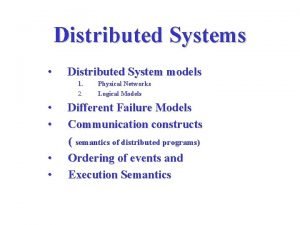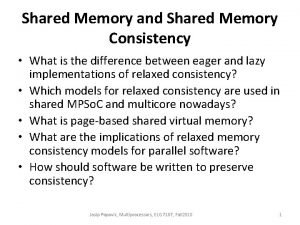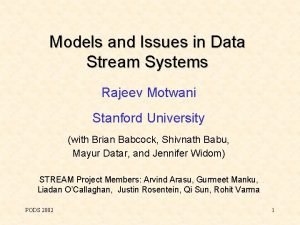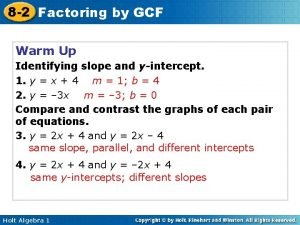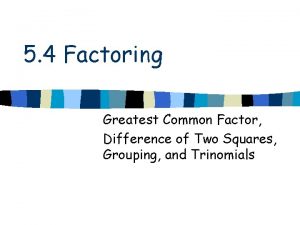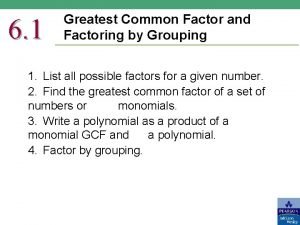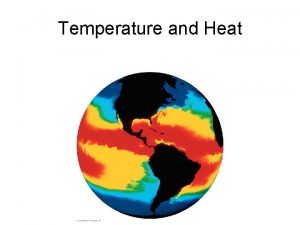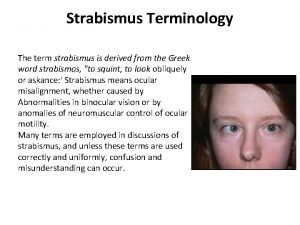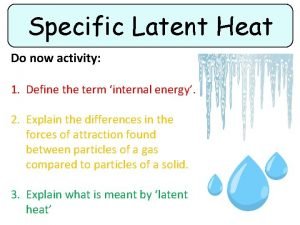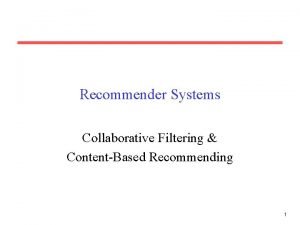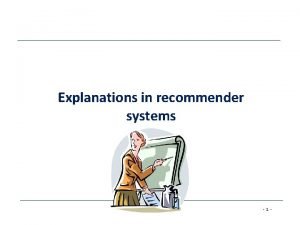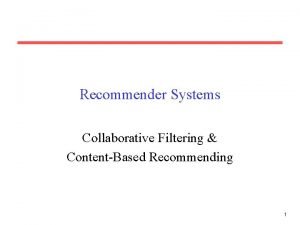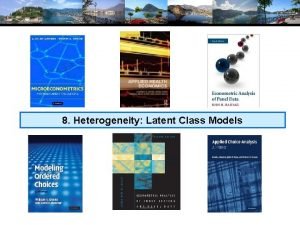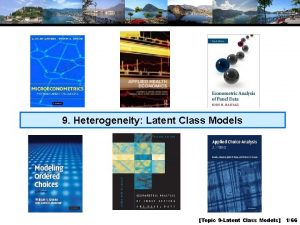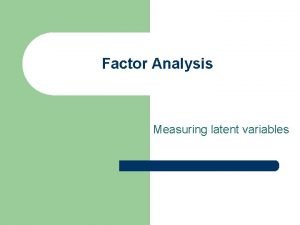Recommender Systems Latent Factor Models CS 246 Mining


























































- Slides: 58

Recommender Systems: Latent Factor Models CS 246: Mining Massive Datasets Jure Leskovec, Stanford University http: //cs 246. stanford. edu

The Netflix Prize � 6/16/2021 Jure Leskovec, Stanford CS 246: Mining Massive Datasets 2

Competition Structure Labels known publicly Labels only known to Netflix Training Data Held-Out Data 3 million ratings 100 million ratings 6/16/2021 1. 5 m ratings Quiz Set: scores posted on leaderboard Test Set: scores known only to Netflix Jure Leskovec, Stanford CS 246: Mining Massive Datasets Scores used in determining final winner 3

The Netflix Utility Matrix R 480, 000 users Matrix R 1 3 4 3 5 4 5 5 5 2 2 3 17, 700 movies 3 2 5 2 3 1 1 3 1 6/16/2021 Jure Leskovec, Stanford CS 246: Mining Massive Datasets 4

Utility Matrix R: Evaluation Matrix R 480, 000 users 1 3 4 3 5 4 5 5 ? ? 3 17, 700 movies Training Data Set 5 3 2 2 3 1 ? ? 1 6/16/2021 Test Data Set ? Jure Leskovec, Stanford CS 246: Mining Massive Datasets True rating of user x on item i Predicted rating 5

Bell. Kor Recommender System �The winner of the Netflix Challenge �Multi-scale modeling of the data: Combine top level, “regional” modeling of the data, with a refined, local view: § Global: Global effects Factorization § Overall deviations of users/movies § Factorization: § Addressing “regional” effects Collaborative filtering § Collaborative filtering: § Extract local patterns 6/16/2021 Jure Leskovec, Stanford CS 246: Mining Massive Datasets 6

Modeling Local & Global Effects �Global: § Mean movie rating: 3. 7 stars § The Sixth Sense is 0. 5 stars above avg. § Joe rates 0. 2 stars below avg. Baseline estimation: Joe will rate The Sixth Sense 4 stars �Local neighborhood (CF/NN): § Joe didn’t like related movie Signs § Final estimate: Joe will rate The Sixth Sense 3. 8 stars 6/16/2021 Jure Leskovec, Stanford CS 246: Mining Massive Datasets 7

Recap: Collaborative Filtering (CF) �Earliest and most popular collaborative filtering method �Derive unknown ratings from those of “similar” movies (item-item variant) �Define similarity measure sij of items i and j �Select k-nearest neighbors, compute the rating § N(i; x): items most similar to i that were rated by x sij… similarity of items i and j rxj…rating of user x on item j N(i; x)… set of items similar to item i that were rated by x 6/16/2021 Jure Leskovec, Stanford CS 246: Mining Massive Datasets 8

Modeling Local & Global Effects �In practice we get better estimates if we model deviations: ^ baseline estimate for rxi μ = overall mean rating bx = rating deviation of user x = (avg. rating of user x) – μ bi = (avg. rating of movie i) – μ 6/16/2021 Problems/Issues: 1) Similarity measures are “arbitrary” 2) Pairwise similarities neglect interdependencies among users 3) Taking a weighted average can be restricting Solution: Instead of sij use wij that we estimate directly from data Jure Leskovec, Stanford CS 246: Mining Massive Datasets 9

Idea: Interpolation Weights wij � 6/16/2021 Jure Leskovec, Stanford CS 246: Mining Massive Datasets 10

Idea: Interpolation Weights wij � Why is this a good idea? 6/16/2021 Jure Leskovec, Stanford CS 246: Mining Massive Datasets 11

Recommendations via Optimization �Goal: Make good recommendations 1 3 4 3 5 4 5 3 3 2 2 § Quantify goodness using RMSE: Lower RMSE better recommendations § Want to make good recommendations on items that user has not yet seen. Can’t really do this! 1 2 1 3 5 5 5 3 § Let’s set build a system such that it works well on known (user, item) ratings And hope the system will also predict well the unknown ratings 6/16/2021 Jure Leskovec, Stanford CS 246: Mining Massive Datasets 12 2 1

Recommendations via Optimization � Predicted rating 6/16/2021 Jure Leskovec, Stanford CS 246: Mining Massive Datasets True rating 13

Detour: Minimizing a function � 6/16/2021 Jure Leskovec, Stanford CS 246: Mining Massive Datasets 14

Interpolation Weights � … learning rate 6/16/2021 Jure Leskovec, Stanford CS 246: Mining Massive Datasets while |wnew - wold| > ε: wold = wnew = wold - · wold 15

Interpolation Weights � Global effects Factorization CF/NN 6/16/2021 Jure Leskovec, Stanford CS 246: Mining Massive Datasets 16

Performance of Various Methods Global average: 1. 1296 User average: 1. 0651 Movie average: 1. 0533 Netflix: 0. 9514 Basic Collaborative filtering: 0. 94 CF+Biases+learned weights: 0. 91 Grand Prize: 0. 8563 6/16/2021 Jure Leskovec, Stanford CS 246: Mining Massive Datasets 17

Latent Factor Models (e. g. , SVD) Serious The Color Purple Geared towards females Braveheart Amadeus Sense and Sensibility Lethal Weapon Ocean’s 11 Geared towards males The Lion King The Princess Diaries Independence Day Funny 6/16/2021 Jure Leskovec, Stanford CS 246: Mining Massive Datasets Dumb and Dumber 18

SVD: A = U VT �“SVD” on Netflix data: R ≈ Q · PT factors users 3 5 2 4 1 4 4 1 5 4 2 3 5 3 3 5 4 4 4 2 3 2 1 3 5 3 ≈ 2 2 2 R 4 4 5 items 1 . 1 -. 4 . 2 -. 5 . 6 . 5 -. 2 . 3 . 5 1. 1 2. 1 . 3 -. 7 2. 1 -2 -1 . 7 . 3 users factors items Latent Factor Models 1. 1 -. 2 . 3 . 5 -2 -. 5 . 8 -. 4 . 3 1. 4 2. 4 -. 9 -. 8 . 7 . 5 1. 4 . 3 -1 1. 4 2. 9 -. 7 1. 2 -. 1 1. 3 2. 1 -. 4 . 6 1. 7 2. 4 . 9 -. 3 . 4 . 8 . 7 -. 6 . 1 PT Q �For now let’s assume we can approximate the rating matrix R as a product of “thin” Q · PT § R has missing entries but let’s ignore that for now! § Basically, we will want the reconstruction error to be small on known ratings and we don’t care about the values on the missing ones 6/16/2021 Jure Leskovec, Stanford CS 246: Mining Massive Datasets 19

Ratings as Products of Factors �How to estimate the missing rating of user x for item i? users 3 5 2 4 2 ? 4 1 2 3 5 3 3 items 5 4 4 4 1 5 4 4 4 2 1 3 5 2 3 3 ≈ 2 2 2 5 qi = row i of Q px = column x of PT 4 . 1 -. 4 . 2 -. 5 . 6 . 5 -. 2 . 3 . 5 1. 1 2. 1 . 3 -. 7 2. 1 -2 -1 . 7 . 3 factors 6/16/2021 4 users factors items 1 1. 1 -. 2 . 3 . 5 -2 -. 5 . 8 -. 4 . 3 1. 4 2. 4 -. 9 -. 8 . 7 . 5 1. 4 . 3 -1 1. 4 2. 9 -. 7 1. 2 -. 1 1. 3 2. 1 -. 4 . 6 1. 7 2. 4 . 9 -. 3 . 4 . 8 . 7 -. 6 . 1 PT Q Jure Leskovec, Stanford CS 246: Mining Massive Datasets 20

Ratings as Products of Factors �How to estimate the missing rating of user x for item i? users 3 5 2 4 2 ? 4 1 2 3 5 3 3 items 5 4 4 4 1 5 4 4 4 2 1 3 5 2 3 3 ≈ 2 2 2 5 qi = row i of Q px = column x of PT 4 . 1 -. 4 . 2 -. 5 . 6 . 5 -. 2 . 3 . 5 1. 1 2. 1 . 3 -. 7 2. 1 -2 -1 . 7 . 3 factors 6/16/2021 4 users factors items 1 1. 1 -. 2 . 3 . 5 -2 -. 5 . 8 -. 4 . 3 1. 4 2. 4 -. 9 -. 8 . 7 . 5 1. 4 . 3 -1 1. 4 2. 9 -. 7 1. 2 -. 1 1. 3 2. 1 -. 4 . 6 1. 7 2. 4 . 9 -. 3 . 4 . 8 . 7 -. 6 . 1 PT Q Jure Leskovec, Stanford CS 246: Mining Massive Datasets 21

Ratings as Products of Factors �How to estimate the missing rating of user x for item i? users 3 5 2 4 2 2. 4 ? 4 1 2 3 5 3 3 items 5 4 4 4 1 5 4 4 4 2 1 3 5 2 2 3 3 ≈ 2 2 5 qi = row i of Q px = column x of PT 4 . 1 -. 4 . 2 -. 5 . 6 . 5 -. 2 . 3 . 5 1. 1 2. 1 . 3 -. 7 2. 1 -2 -1 . 7 . 3 f factors 6/16/2021 4 users f factors items 1 1. 1 -. 2 . 3 . 5 -2 -. 5 . 8 -. 4 . 3 1. 4 2. 4 -. 9 -. 8 . 7 . 5 1. 4 . 3 -1 1. 4 2. 9 -. 7 1. 2 -. 1 1. 3 2. 1 -. 4 . 6 1. 7 2. 4 . 9 -. 3 . 4 . 8 . 7 -. 6 . 1 PT Q Jure Leskovec, Stanford CS 246: Mining Massive Datasets 22

Latent Factor Models Serious The Color Purple Geared towards females Braveheart Amadeus Lethal Weapon Sense and Sensibility Ocean’s 11 Geared Factor 1 towards males The Princess Diaries Factor 2 The Lion King Independence Day Funny 6/16/2021 Jure Leskovec, Stanford CS 246: Mining Massive Datasets Dumb and Dumber 23

Latent Factor Models Serious The Color Purple Geared towards females Braveheart Amadeus Lethal Weapon Sense and Sensibility Ocean’s 11 Geared Factor 1 towards males The Princess Diaries Factor 2 The Lion King Independence Day Funny 6/16/2021 Jure Leskovec, Stanford CS 246: Mining Massive Datasets Dumb and Dumber 24

Recap: SVD n n �Remember SVD: § § A: Input data matrix U: Left singular vecs V: Right singular vecs : Singular values m A m VT U �So in our case: “SVD” on Netflix data: R ≈ Q · PT A = R, Q = U, PT = VT 6/16/2021 Jure Leskovec, Stanford CS 246: Mining Massive Datasets 25

SVD: More good stuff � 6/16/2021 Jure Leskovec, Stanford CS 246: Mining Massive Datasets 26

factors 1 3 5 2 4 1 4 4 1 5 4 2 3 5 3 3 5 4 3 4 4 2 -. 4 . 2 -. 5 . 6 . 5 -. 2 . 3 . 5 1. 1 2. 1 . 3 -. 7 2. 1 -2 -1 . 7 . 3 4 2 1 3 5 3 2 2 2 . 1 items users 4 5 users 1. 1 -. 2 . 3 . 5 -2 -. 5 . 8 -. 4 . 3 1. 4 2. 4 -. 9 -. 8 . 7 . 5 1. 4 . 3 -1 1. 4 2. 9 -. 7 1. 2 -. 1 1. 3 2. 1 -. 4 . 6 1. 7 2. 4 . 9 -. 3 . 4 . 8 . 7 -. 6 . 1 Q PT � 6/16/2021 Jure Leskovec, Stanford CS 246: Mining Massive Datasets 27 factors items Latent Factor Models

Finding the Latent Factors

� factors 1 3 5 2 4 1 4 4 1 5 4 2 3 5 3 3 6/16/2021 5 4 3 4 4 2 -. 4 . 2 -. 5 . 6 . 5 -. 2 . 3 . 5 1. 1 2. 1 . 3 -. 7 2. 1 -2 -1 . 7 . 3 4 2 1 3 5 3 2 2 2 . 1 items users 4 5 users 1. 1 -. 2 . 3 . 5 -2 -. 5 . 8 -. 4 . 3 1. 4 2. 4 -. 9 -. 8 . 7 . 5 1. 4 . 3 -1 1. 4 2. 9 -. 7 1. 2 -. 1 1. 3 2. 1 -. 4 . 6 1. 7 2. 4 . 9 -. 3 . 4 . 8 . 7 -. 6 . 1 Q Jure Leskovec, Stanford CS 246: Mining Massive Datasets PT 29 factors items Latent Factor Models

Back to Our Problem �Want to minimize SSE for unseen test data �Idea: Minimize SSE on training data § Want large k (# of factors) to capture all the signals § But, SSE on test data begins to rise for k > 2 �This is a classical example of overfitting: § With too much freedom (too many free parameters) the model starts fitting noise 1 3 4 3 5 4 5 3 3 2 ? 5 5 ? ? 2 1 3 ? ? 1 § That is it fits too well the training data and thus not generalizing well to unseen test data 6/16/2021 Jure Leskovec, Stanford CS 246: Mining Massive Datasets 30

Dealing with Missing Entries 1 3 4 3 5 4 5 3 3 2 ? �To solve overfitting we introduce regularization: 5 5 ? ? 2 1 3 ? ? 1 § Allow rich model where there is sufficient data § Shrink aggressively where data is scarce “error” 1, 2 … user set regularization parameters “length” Note: We do not care about the “raw” value of the objective function, but we care about P, Q that achieve the minimum of the objective 6/16/2021 Jure Leskovec, Stanford CS 246: Mining Massive Datasets 31

The Effect of Regularization serious The Color Purple Geared towards females Braveheart Amadeus Sense and Sensibility Lethal Weapon Ocean’s 11 Factor 1 The Princess Diaries Factor 2 The Lion King minfactors “error” + “length” 6/16/2021 Geared towards males Dumb and Dumber Independence Day funny Jure Leskovec, Stanford CS 246: Mining Massive Datasets 32

The Effect of Regularization serious The Color Purple Geared towards females Braveheart Amadeus Sense and Sensibility Lethal Weapon Ocean’s 11 Factor 1 The Princess Diaries Factor 2 The Lion King minfactors “error” + “length” 6/16/2021 Geared towards males Dumb and Dumber Independence Day funny Jure Leskovec, Stanford CS 246: Mining Massive Datasets 33

The Effect of Regularization serious The Color Purple Geared towards females Braveheart Amadeus Sense and Sensibility Lethal Weapon Ocean’s 11 Factor 1 The Princess Diaries Factor 2 The Lion King minfactors “error” + “length” 6/16/2021 Geared towards males Dumb and Dumber Independence Day funny Jure Leskovec, Stanford CS 246: Mining Massive Datasets 34

The Effect of Regularization serious The Color Purple Geared towards females Braveheart Amadeus Sense and Sensibility Lethal Weapon Ocean’s 11 Factor 1 The Princess Diaries Factor 2 The Lion King minfactors “error” + “length” 6/16/2021 Geared towards males Dumb and Dumber Independence Day funny Jure Leskovec, Stanford CS 246: Mining Massive Datasets 35

Stochastic Gradient Descent � How to compute gradient of a matrix? Compute gradient of every element independently! 6/16/2021 Jure Leskovec, Stanford CS 246: Mining Massive Datasets 36

Stochastic Gradient Descent � 6/16/2021 Jure Leskovec, Stanford CS 246: Mining Massive Datasets 37

SGD vs. GD Value of the objective function �Convergence of GD vs. SGD Iteration/step 6/16/2021 Jure Leskovec, Stanford CS 246: Mining Massive Datasets GD improves the value of the objective function at every step. SGD improves the value but in a “noisy” way. GD takes fewer steps to converge but each step takes much longer to compute. In practice, SGD is much faster! 38

Stochastic Gradient Descent � 6/16/2021 Jure Leskovec, Stanford CS 246: Mining Massive Datasets 39

Koren, Bell, Volinksy, IEEE Computer, 2009 6/16/2021 Jure Leskovec, Stanford CS 246: Mining Massive Datasets 40

Extending Latent Factor Model to Include Biases

Modeling Biases and Interactions user bias movie bias Baseline predictor § Separates users and movies § Benefits from insights into user’s behavior § Among the main practical contributions of the competition user-movie interaction User-Movie interaction � Characterizes the matching between users and movies � Attracts most research in the field � Benefits from algorithmic and mathematical innovations �μ = overall mean rating �bx = bias of user x �bi = bias of movie i 6/16/2021 Jure Leskovec, Stanford CS 246: Mining Massive Datasets 42

Baseline Predictor �We have expectations on the rating by user x of movie i, even without estimating x’s attitude towards movies like i – Rating scale of user x – Values of other ratings user gave recently (day-specific mood, anchoring, multi-user accounts) 6/16/2021 – (Recent) popularity of movie i – Selection bias; related to number of ratings user gave on the same day (“frequency”) Jure Leskovec, Stanford CS 246: Mining Massive Datasets 43

Putting It All Together Overall mean rating Bias for user x Bias for movie i User-Movie interaction �Example: § Mean rating: = 3. 7 § You are a critical reviewer: your ratings are 1 star lower than the mean: bx = -1 § Star Wars gets a mean rating of 0. 5 higher than average movie: bi = + 0. 5 § Predicted rating for you on Star Wars: = 3. 7 - 1 + 0. 5 = 3. 2 6/16/2021 Jure Leskovec, Stanford CS 246: Mining Massive Datasets 44

Fitting the New Model �Solve: goodness of fit is selected via gridsearch on a validation set regularization �Stochastic gradient decent to find parameters § Note: Both biases bx, bi as well as interactions qi, px are treated as parameters (and we learn them) 6/16/2021 Jure Leskovec, Stanford CS 246: Mining Massive Datasets 45

Performance of Various Methods Global average: 1. 1296 User average: 1. 0651 Movie average: 1. 0533 Netflix: 0. 9514 Basic Collaborative filtering: 0. 94 Collaborative filtering++: 0. 91 Latent factors: 0. 90 Latent factors+Biases: 0. 89 Grand Prize: 0. 8563 6/16/2021 Jure Leskovec, Stanford CS 246: Mining Massive Datasets 46

The Netflix Challenge: 2006 -09

Temporal Biases Of Users �Sudden rise in the average movie rating (early 2004) § Improvements in Netflix § GUI improvements § Meaning of rating changed �Movie age § Users prefer new movies without any reasons § Older movies are just inherently better than newer ones Y. Koren, Collaborative filtering with temporal dynamics, KDD ’ 09 6/16/2021 Jure Leskovec, Stanford CS 246: Mining Massive Datasets 48

Temporal Biases & Factors �Original model: rxi = +bx + bi + qi ·px �Add time dependence to biases: rxi = +bx(t)+ bi(t) +qi · px § Make parameters bx and bi to depend on time § (1) Parameterize time-dependence by linear trends (2) Each bin corresponds to 10 consecutive weeks �Add temporal dependence to factors § px(t)… user preference vector on day t 6/16/2021 Y. Koren, Collaborative filtering with temporal dynamics, KDD ’ 09 Jure Leskovec, Stanford CS 246: Mining Massive Datasets 49

Performance of Various Methods Global average: 1. 1296 User average: 1. 0651 Movie average: 1. 0533 Netflix: 0. 9514 Basic Collaborative filtering: 0. 94 Still no prize! Getting desperate. Try a “kitchen sink” approach! Collaborative filtering++: 0. 91 Latent factors: 0. 90 Latent factors+Biases: 0. 89 Latent factors+Biases+Time: 0. 876 Grand Prize: 0. 8563 6/16/2021 Jure Leskovec, Stanford CS 246: Mining Massive Datasets 50

6/16/2021 Jure Leskovec, Stanford CS 246: Mining Massive Datasets 51

Standing on June 26 th 2009 June 26 th submission triggers 30 -day “last call” 6/16/2021 Jure Leskovec, Stanford CS 246: Mining Massive Datasets 52

The Last 30 Days � Ensemble team formed § Group of other teams on leaderboard forms a new team § Relies on combining their models § Quickly also get a qualifying score over 10% � Bell. Kor § Continue to get small improvements in their scores § Realize they are in direct competition with team Ensemble � Strategy § Both teams carefully monitoring the leader board § Only sure way to check for improvement is to submit a set of predictions § This alerts the other team of your latest score 6/16/2021 Jure Leskovec, Stanford CS 246: Mining Massive Datasets 53

24 Hours from the Deadline � Submissions limited to 1 a day § Only 1 final submission could be made in the last 24 h � 24 hours before deadline… § Bell. Kor team member in Austria notices (by chance) that Ensemble posts a score that is slightly better than Bell. Kor’s � Frantic last 24 hours for both teams § Much computer time on final optimization § Carefully calibrated to end about an hour before deadline � Final submissions § Bell. Kor submits a little early (on purpose), 40 mins before deadline § Ensemble submits their final entry 20 mins later § …. and everyone waits…. 6/16/2021 Jure Leskovec, Stanford CS 246: Mining Massive Datasets 54

6/16/2021 Jure Leskovec, Stanford CS 246: Mining Massive Datasets 55

Million $ Awarded Sept 6/16/2021 Jure Leskovec, Stanford CS 246: Mining Massive Datasets st 21 2009 56

What’s the moral of the story? Submit early! 6/16/2021 Jure Leskovec, Stanford CS 246: Mining Massive Datasets 57

Acknowledgments �Some slides and plots borrowed from Yehuda Koren, Robert Bell and Padhraic Smyth �Further reading: § Y. Koren, Collaborative filtering with temporal dynamics, KDD ’ 09 § http: //www 2. research. att. com/~volinsky/netflix/bpc. html § http: //www. the-ensemble. com/ 6/16/2021 Jure Leskovec, Stanford CS 246: Mining Massive Datasets 58
 Latent factors recommender system
Latent factors recommender system Cs 246: mining massive data sets
Cs 246: mining massive data sets Introduction to recommender systems
Introduction to recommender systems Markus zanker
Markus zanker Weighted hybrid recommender systems
Weighted hybrid recommender systems Formula for specific latent heat of fusion
Formula for specific latent heat of fusion Self-paced learning for latent variable models
Self-paced learning for latent variable models Knowledge based recommendation
Knowledge based recommendation Strip mining vs open pit mining
Strip mining vs open pit mining Strip mining vs open pit mining
Strip mining vs open pit mining Difference between strip mining and open pit mining
Difference between strip mining and open pit mining Difference between text mining and web mining
Difference between text mining and web mining Mining multimedia databases in data mining
Mining multimedia databases in data mining Eck
Eck En un zoológico hay 246 aves
En un zoológico hay 246 aves It 246
It 246 Afman 10-246
Afman 10-246 Place value of 246
Place value of 246 Junghoo cho ucla
Junghoo cho ucla 246 regel insuline
246 regel insuline Psalm 246
Psalm 246 Redondear a la decena de millar ejemplos
Redondear a la decena de millar ejemplos Extendible hashing visualization
Extendible hashing visualization Round 54 681 to the nearest ten thousand
Round 54 681 to the nearest ten thousand Mining massive datasets
Mining massive datasets Modals and semi modals difference
Modals and semi modals difference Nn multi factor
Nn multi factor How to understand scale drawings
How to understand scale drawings Scale drawings and models
Scale drawings and models Systems and system models
Systems and system models Fundamental model of distributed system
Fundamental model of distributed system Distributed system models
Distributed system models The engineering design of systems: models and methods
The engineering design of systems: models and methods Memory consistency models in distributed systems
Memory consistency models in distributed systems Models and issues in data stream systems
Models and issues in data stream systems Factor by grouping examples
Factor by grouping examples Factoring greatest common factor
Factoring greatest common factor Average of sine wave
Average of sine wave What is factor isolating questions
What is factor isolating questions Factoring greatest common factor
Factoring greatest common factor Lcm of 12 and 18
Lcm of 12 and 18 Water latent heat of vaporization btu/lb
Water latent heat of vaporization btu/lb Latent heat
Latent heat Latent heat of lead
Latent heat of lead Syphilis
Syphilis Orthophoria
Orthophoria Heterophoria vs heterotropia
Heterophoria vs heterotropia Latent squint meaning
Latent squint meaning Latent heat of water btu/lb
Latent heat of water btu/lb Latent dreams definition
Latent dreams definition Latent heat definition physics
Latent heat definition physics Specific heat capacity equation with power
Specific heat capacity equation with power Manifest and latent functions
Manifest and latent functions Latent functions of family
Latent functions of family Latent tb chest x ray
Latent tb chest x ray Manifest and latent functions examples
Manifest and latent functions examples Latent hyperopia
Latent hyperopia Positional hypermetropia
Positional hypermetropia Besoin latent def
Besoin latent def



